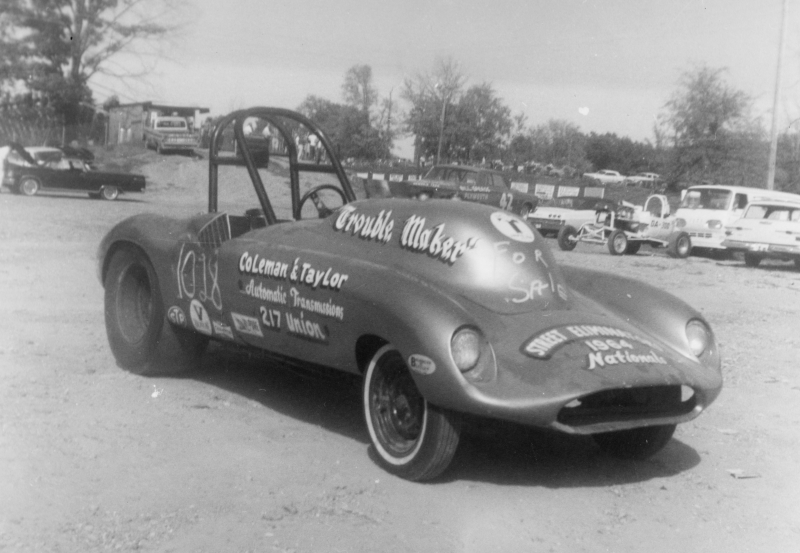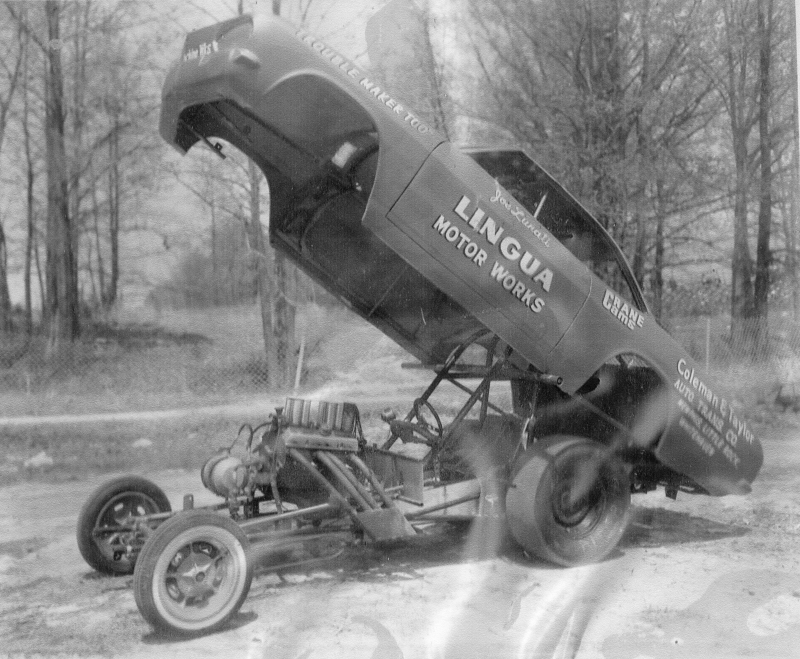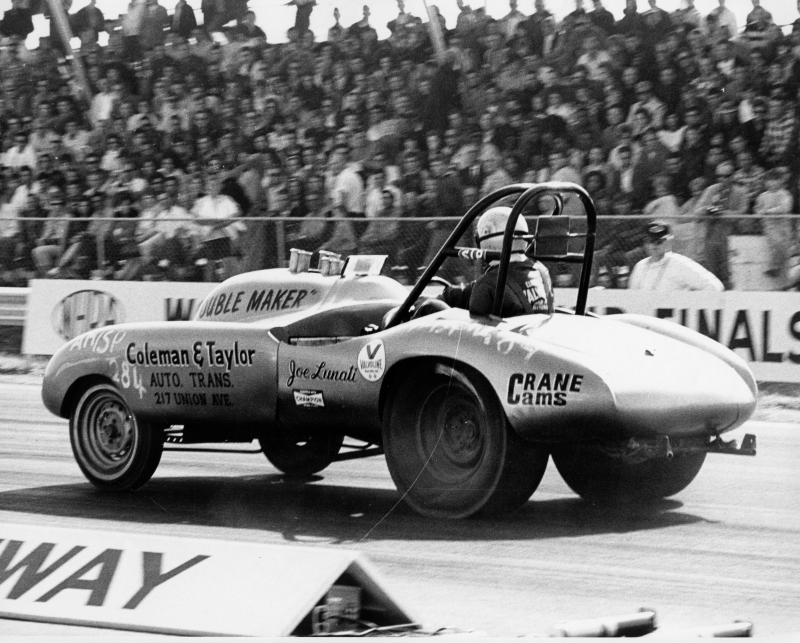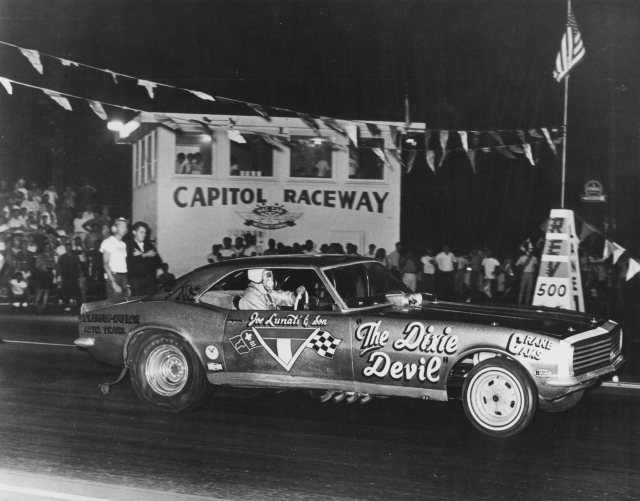
Joe Lunati’s “Trouble Maker” in its 1960’s battle trim. The car ran in NHRA’s A-Modified Sports class, holding AM/SP class records nine different times. The handicap ET of 10.18 seconds is show-polished on the Devin body’s flank, but the car was easily capable of running mid 9 second, no break-out times.
by Jim Hill
Like many a racing hobbyist, Joe Lunati had the desire to go fast in a car he built and tuned. He began street drag in Memphis, but soon moved on to safer and more legal action on the area’s sanctioned drag strips. Joe wanted to move up to a faster ride, and in 1963 he built a homemade chassis. Exhibiting the shrewdness that would one day define his business career, Joe evaluated the A Modified Sports (AM/SP) ET record (on which racing handicaps were then based) and decided the car would be highly competitive in Street Eliminator. NHRA’s Street Eliminator featured Gassers, Modified Productions, Street Roadsters, Modified Sports and Stock Sports classes. It was the modern extension of the classic hot rod, with cars built specifically for racing and no street driving in question.
In those days very few racing-specific parts were available for outright purchase. Racers like Lunati learned either from someone else or by trial and error the skills required to build a race car. Like most 60’s racers, Joe built and tuned his own engines. He assembled a Hilborn injected, 377 cubic inch stroker small-block Chevy from used engine parts he bought from a local racer. For consistency and reliability he backed his engine with a Memphis-built Coleman & Taylor automatic transmission and went racing. The chassis was cloaked in a somewhat dented, two-seat Devin roadster body that deviously concealed the car’s formidable capabilities. Joe won often with this unlikely race car, the A-Modified/Sports class three times at the NHRA Nationals, nine separate NHRA AM/SP class ET and speed records, and Street Eliminator at the 1964 and 1966 NHRA Nationals. His careful selection of the AM/SP class allowed him to selectively increase performance just as much as he needed to best the competition. It was a nearly perfect “edge” and made Joe’s homemade hot rod a genuine killer car in eliminations.
By the mid-1960’s the wildly popular A/Factory Experimental class had evolved into what became known as Funny Cars, so-named because of their radically altered bodies that made them look “funny”. These early Funny Cars became a lucrative way to earn cash by match racing and in booked-in, multi-car racing shows. Brand favorites Chevy, Pontiac, Ford, Mercury, Dodge and Plymouth brought paying spectators in the gates and every track was booking Funny Cars.

When mid-1960’s attention turned to Funny Cars, Lunati converted his AM/SP car to a low-buck Funny. On the floor of his home garage he lengthened the car’s 92” wheelbase to 108”, and then built a homemade fiberglass Corvair body for cover. The car’s extreme lightweight of 1,700 lbs. allowed him to stick with his 377 cubic inch Hilborn injected small-block Chevy, running high 8-second ET’s at 170-plus mph.
Still working on a hobbyist’s home garage budget, Joe bought the sheetmetal from a ‘65 Corvair and molded his own fiberglass body. He lengthened the original 92” wheelbase out to 108” to improve handling at the higher speeds he expected and dropped the ‘glass body onto his homebuilt chassis. Although very sturdily built, the car weighed only 1,700 lbs., far less than the typical 2,500+ lbs. for most of the current Funny Cars. The car’s considerably lighter weight gave Joe’s Corvair an advantage, and that allowed him to stick with his proven 377” small-block Chevy for reliable power. It all worked very well, and Joe’s homebuilt Funny was soon running high eight-second ET’s. He was also winning open competition events and match races, gaining a reputation with Southeastern track owners and fans. This success came with a car dubbed “unsafe at any speed” by author Ralph Nader. One could only wonder Nader’s reaction would have been had he known Lunati’s one-off Corvair was cranking out 170 mph speeds.
In early 1966 Funny Car technology took a major leap forward with the introduction of the factory-backed Mercury Comets. These were professionally-built, lightweight tube steel chassis with lift-off fiberglass bodies. They began running normally aspirated, nitro burning engines, but soon the teams moved to supercharged engines. The “Eliminator 1” Mercury Comet of Dyno Don Nicholson forever changed the face of Funny Car racing. ET’s dropped and speeds soared, but so did the cost of Funny Car racing.
To keep up, Joe built his own tube chassis Funny Car, once again on the concrete floor of his garage. This car featured a fiberglass 1967 Chevy Camaro body. With a nod to showmanship, he named it “The Dixie Devil”. For power Joe again reached forward, building a nitro fueled, big-block 427 Chevy, boosted by a GM 6-71 supercharger. His outings with the new car were quickly successful. Lunati even found himself in the final round of Funny Car Eliminator at the 1967 NHRA Nationals. This meteoric rise came just one year after his 1966 Street Eliminator win.
Joe’s home-built racer lost in the final to Doug Thorley’s Corvair, but this low-buck effort made many take notice. Not long after the ’67 Nationals, Lunati’s ’67 Camaro was destroyed in a crash at LaPlace, Louisiana. Rather than immediately build a new car, the crash made Lunati reflect on the rising costs and hazards of running a nitro Funny Car. Even with his quickly achieved success Joe saw ominous clouds forming on the horizon.
Joe had funded the Camaro as a weekend racing enterprise without a major financial sponsor. The expenses of fielding a competitive, nitro Funny Car were rising almost as fast as their 200+ mph speeds, and most of the teams were either factory backed or enjoyed funding through big sponsorships. To remain competitive with the ever-escalating speeds meant teams had to push their engines to dangerous extremes, with expensive engine damage the usual result. The rapidly rising expenses came with an even more alarming increase in serious accidents.
The Funny Car class became plagued with engine and transmission explosions, terrible oil fires and spectacular crashes. Many notable drivers suffered serious injuries and burns. With a wife and family to consider, Joe decided to get out of Funny Car racing before fate stepped in. He decided to turn his attention instead to the racing products business, and specifically, camshafts and valve train.

Joe Lunati’s “Trouble Maker” A-Modified Sports Devin won the NHRA Street Eliminator title at the U.S. Nationals in both 1964 and 1966. Joe built the car’s chassis on the floor of his home garage, including fabricating the lumpy “hood” to meet AM/SP class rules.
Joe’s first involvement with camshafts came after learning the craft while working at a Memphis production engine rebuilder. After he finished his day job grinding cams for engine rebuilds he would stay late at the shop and grind what became known as “cheater stock” cams. In 1968 he sold his first cheater stock cam, launching him into the racing cam business.
Joe had uncovered a niche market with NHRA Stock Eliminator racers, a popular category in Memphis and on the east coast. The NHRA rules of those days allowed a clever cam grinder to create a cam that increased horsepower yet still checked as “legal” in the NHRA tech teardown barn. The rules specified which specs of a factory cam would be checked, and Joe’s early stocker cams focused on taking advantage of the areas that weren’t checked. The result was an immediate, notable increase in horsepower that helped racers gain as much as a half-second reduction in elapsed time. It was a spectacular performance improvement.
Joe’s little niche was mostly ignored by the major cam companies. He gained both knowledge and a following with his Junior Stock cheater cams. These were reground on stock camshaft cores that carried the required original factory part number.
In 1968 Joe purchased his first cam grinder and stepped wholeheartedly into the racing cam business. He called his new venture Lunati Cams and decided to focus his efforts on drag racing and regional circle short track racing.
Joe’s Jr. Stock cheater cams continued to be his core market and allowed him to expand into the more lucrative small-block and big-block Chevy drag racing and Late Model Dirt Modified circle track markets. His friendly, outgoing personality and reputation for honesty helped his new cam and valvetrain company grow quickly.
Within a few years Lunati branched out into selling complete engine assembly products–crankshafts, rods, pistons, as well as cam and valvetrain products for racing. Lunati had become a “one-stop” source for do-it-yourself engine builders and smaller professional race engine builders. A partnership with Bill Taylor, another Memphis racer and founder of TCI (Torque Converters Inc.) resulted in a line of forged aluminum pistons, marketed as “Lunati/Taylor.”
During these decades of growth, Joe Lunati continued to be at the center of his company. His customers and fellow racers came to respect and trust him as a man of his word who backed his products. A call to Lunati often resulted in Joe himself taking the call, answering tech questions and taking orders from racers and engine builders.
For assistance in growing the new company Joe turned to his wife Peggy, his daughter Judy and son Joey. The Lunati family was involved in the operation from the earliest, with Joe working both in the shop and the offices to keep the ball rolling. This day-to-day stability also allowed Joe to use his vision in reading the market and customer base as well as permitted him to expand his deal-making activities. Joe’s easy-going manner and strong code of business ethics brought a steady stream of opportunities for the former Memphis racer.
Joe’s wife Peggy, who worried about his safety while he was driving the dangerous, unpredictable nitro Funny Cars, jumped wholeheartedly into her key role with the growing company. Assisted by daughter Judy, the mother-daughter team handled daily office and business chores, including finances and banking. Joey Lunati quickly became a multi-talented, key employee, manning the phones to answer tech assistance calls and sales.

When Funny Cars advanced to flip-top ‘glass bodies and blown motors, Joe Lunati built this ’67 Camaro, again in his home garage. The nitro-fueled, 427 big-block Chevy would be Joe’s last race car before opening Lunati Cams, and it ran 7 second ET’s at 200+ mph. Joe drove this car to Funny Car Eliminator runner-up at the 1967 NHRA Nationals, and then crashed it a few short weeks later at Baton Rouge, Louisiana. After that Lunati retired from driving to concentrate on his growing business.
Along the way Joe also collected numerous personal accolades recognizing his career in racing and the industry. He was inducted into the NHRA Drag Racing Hall of Fame in 2006, the NHRA Southeast Division Hall of Fame in 1987, and Hot Rod Magazine’s 50th Anniversary Hall of Fame in 1977.
In the early 1990’s, Wall Street’s big-money interests came to view the performance-racing aftermarket as a cash-rich arena ripe with potential for lucrative acquisitions. One of these investment groups purchased industry icon Holley Carburetor then set out to diversify their holdings with other performance automotive companies. Holley quickly went on a buying binge, placing Lunati squarely in its sights. After negotiations, Joe Lunati sold Lunati Cams to Holley Performance in 1998.
By design of the new ownership, Joe’s company was quickly changed from its one-on-one customer base to a completely different business model. Rather than focusing on its racer-direct and engine builder customer base, the new managers decided to re-make Lunati into a wholesale distribution manufacturer. Individual service and fast turn-around were abandoned for large, bulk freight orders to national warehouse distributing firms. Long term customers were turned away and told to buy from other sources.
The marketplace failed to embrace this new direction. The new Lunati struggled, sales declined and Lunati’s original, profit generating customer base fell by the wayside. Added to this, the national economy had begun an agonizing decline. After weathering increasingly tough economic times, the financial managers at Holley decided it was time to divest of some of its investments. Lunati was placed on the block.
In 2007 Lunati Cams & Cranks was purchased from Holley Performance Products. The new owners are also investors, but this partnership is comprised of industry and racing veterans, rather than Wall Street capitalists. Where the prior owners had no understanding or involvement in the market, Lunati’s new owners are industry insiders. One of the first moves made was to return the company’s direction to the products and racer service that made Lunati successful.
Products include, of course, a complete selection of racing and performance cams and valvetrain components. Cams and components are joined by forged aluminum pistons, wrist pins and piston rings, forged steel crankshafts, main and rod bearings, both H-Beam and I-Beam forged steel connecting rods and any combination of these components matched to your specific combination of engine components and drivetrain. All Lunati products are expertly recommended by the hands-on tech staff. Likely as not, when you call you’ll be speaking with a tech staff member who’s also a weekend racer and knows what works best.
By returning to its prior successful business philosophy Lunati Power has prospered and established its own customer base, providing racers and engine builders with top quality products, cutting-edge technology, racer-friendly tech support, “I need it now” service and affordable prices.
















